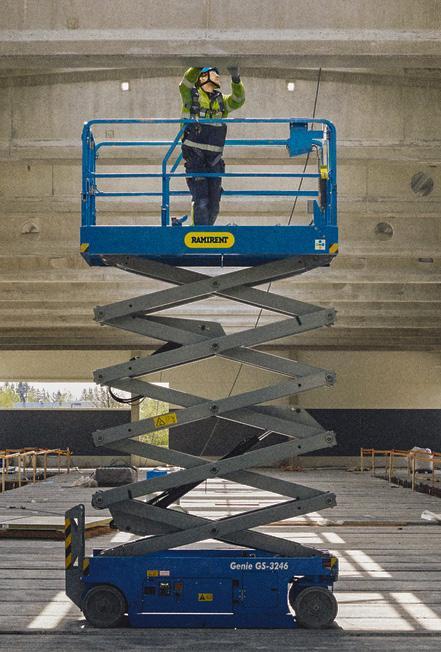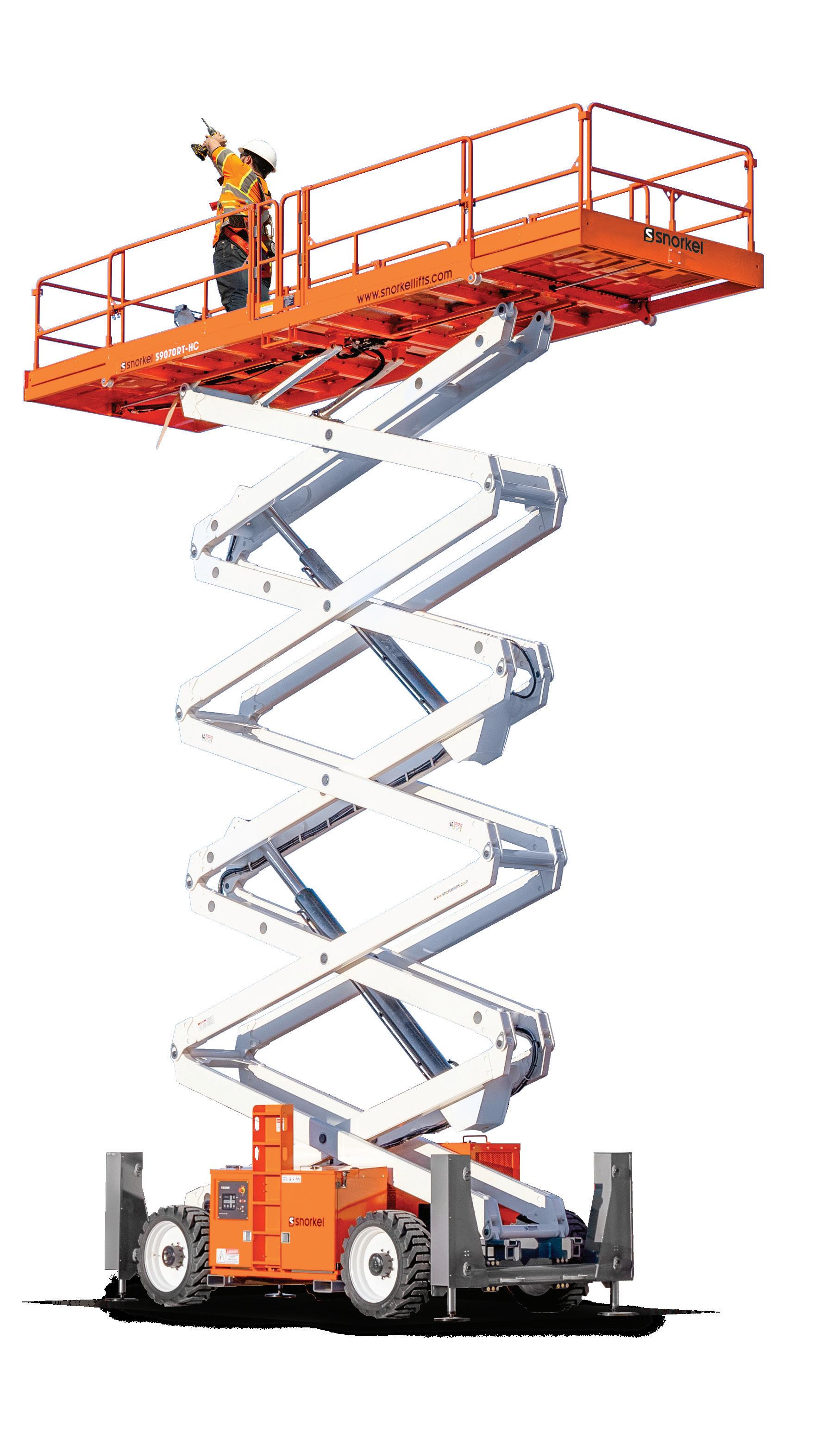
6 minute read
IPAF NEWS ROUNDUP
Will We Ever Eradicate Falls?
Industry experts comment on whether the powered access industry will ever completely eliminate this type of incident, which too often lead to injuries and deaths.
From 2012 to 2022, there were 4,374 reports, including 4,462 lost-time incidents of which there were 585 fatalities. There have been 41 countries from which reports have been gathered across the 10-year period. Since IPAF began collecting and analyzing accident data in 2012, falls from platforms have consistently been the most common underlying cause of injury and death when using MEWPs.
Machine types involved in falls from the platform include static boom (1b) type machines (30.8 percent of incidents), mobile vertical (3a) types (28.8 percent) and mobile booms (3b) (22.8 percent).
Because any accident relating to MEWPs is one too many, this information calls in to question whether the industry will ever eradicate falls from MEWPs. Can the industry focus on this single issue, place the necessary resources and erase this potential hazard to result in zero fatal accidents?
Scott Owyen, director of training at Genie; Tony Groat, regional manager at IPAF; Paul Baillargeon, owner of Aerial Lift Safety Solutions; TJ Lyons, contractor at DPR Construction; Mark Hinkle, president of Hinkle Equipment Rental; and Ebbe Christensen, IPAF NA council chair and president and CEO at Ruthmann Reachmaster North America, LP, dig into this question.
The Problem
There are essentially three ways in which an individual can fall from a MEWP, according to Owyen:
1. Exiting the platform at height without following the proper guidance from the manufacturer or failing to wear the proper personal fall protection equipment (PFPE).
To prevent this, manufacturers will provide guidance on how to safely exit a MEWP at height, and that guidance must be followed to the letter. Note that guidance for exiting a scissor lift will be different than that for a boom, and it is critical to follow the correct guidance for the MEWP being used.
2. Standing on the guardrails.
This is typically the result of using the wrong machine for the application and should never be done under any circumstance. Similarly, placing planks on the mid or top rails or any kind of steps or ladders in the platform creates the same hazardous conditions.
3. Being ejected or catapulted from the platform.
This can be caused by driving the machine too quickly and running over an obstacle, driving the machine over a void in the ground or on a surface that cannot sustain the weight of the MEWP, the platform becoming entangled with a structure or the operator trying to release it by driving away from the obstacle or by being struck by an object or vehicle.
Other root causes of accidents involving MEWPs can include: • lack of an effective MEWP safe-use plan by users and employers; • inadequate operator training; • inadequate supervision; • improper MEWP selection; • lack of concern over the risk; • inconsistent requirement for PFPE; • lack of a solution to have the operator connected to a MEWP operator anchorage prior to MEWP movement. “Much like with car accidents, the challenge is that multiple factors are at play at the same time: location, ground conditions, weather work type, equipment type, equipment condition, operator skills and competence, training and site management,” Christensen says. “A more detailed review of the falls (through a risk assessment) is needed to reveal more details about the core reason for the fall.”
PFPE
Many falls involve the operator not wearing the PFPE – or even knowing whether or not it’s required.
“The issue of whether PFPE should be required on scissor lifts has been, and still is, a constant source of confusion,” Owyen says. “There still seems to be no standard approach to making that determination, and the thought processes, standards and

JLG
RAMIRENT

Proper training and education is key in helping to eliminate falls from MEWPs.

manufacturer recommendations are all over the place.”
Lyons, on the other hand, thinks scissor-type lifts with rails provide adequate fall protection.
“A significant failure for the construction industry was requiring PFPE even though that protection was already designed in the unit. We encumber those workers with ‘safety,’ and that is unfortunate,” Lyons says.
Per ANSI A92.22-2021 and CSA B354.7-17 standards, the guardrail system of the MEWP is the primary fall protection for occupants. When required to use personal fall protection, either fall restraint or fall arrest, operators and occupants shall comply with the instructions provided by the manufacturer regarding anchorage(s).
Standards for Type 1, Group A (1a) manually propelled elevating work platforms and Type 3, Group A (3a) self-propelled elevating work platforms, such as scissor lifts and single personnel lifts, do not require the use of PFPE in addition to guardrails.
“If PFPE was universally required, it would eliminate any user or operator confusion on when it is required,” Groat says. “It would add another layer of protection. It is a requirement in Canada, and falls from MEWPs are not widely seen.”
Hinkle notes that the standards in place seem to be intended for users of MEWPS who are either decently informed or under the supervision of managers that have some respect for the risks and thus provide PFPE and instruction in its use.
For those MEWPs that currently require PFPE, Baillargeon says it’s not enough to only be “wearing” a safety harness.
“The MEWP operator must have the safety lanyard connected each and every time prior to utilizing the MEWP lift control function switches,” Baillargeon says.
Finally, Lyons notes that people who fail to wear PFPE should face some kind of penalty.
“[There should be] clear consequences when someone is assigned PFPE and chooses not to wear it or does something unsafe like climbing on a rail,” Lyons says. “Though this is a worker behavior, it should be an OSHA violation.”
Training
While the operator should be responsible to comply with requirements defined by the employer, the employer needs to ensure the operator is qualified for the task, properly supervised to ensure compliance with requirements of the safe-use plan and provided with the equipment and tools necessary to safely perform the task in a work environment safe from harm, says Groat.
Groat adds that MEWP training incorporates aspects for fall hazards, but it alone is not a fall protection training course.
“MEWP operator training is general in nature and specific site conditions require more detailed training based on selected fall protection equipment, site conditions, etc.,” Groat says.
Owyen agrees that more training should be required.
“Unfortunately, there are a lot of 20- to 30-minute online and in-person courses that market themselves as complete operator
EXTREME a cap city
What’s bigger than big? Only the largest ultra-capacity rough terrain scissor lift in North America. Meet the new Snorkel S9070RT-HC, built with a dual-powered twin extension deck as standard for a substantial lifting capacity that maximizes productivity on the job. Designed with a large platform working area and extra-wide pallet gate, this lift has added rough terrain capabilities that makes the S9070RT-HC a premier performer on all jobsites.

4x4

ROUGH TERRAIN
EXTRA WIDE
PALLET GATE 2,000lb
PLATFORM CAPACITY
READY TO CARRY
FOR MORE INFORMATION CALL Snorkel™ at +1 (785) 989-3000 or visit www.snorkellifts.com
©2022 Snorkel. All rights reserved.





